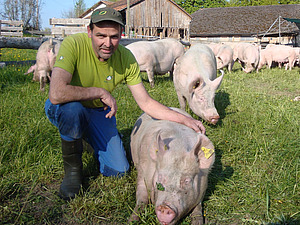"We need to work more closely with practitioners"
Voices on biodiversity
Peter Haldemann is an organic farmer in Raperswilen in the canton of Thurgau. The arable crops and pig farmer is a member of the board of the Thurgau Agriculture Association. (Photo: made available)
Peter Haldemann is an organic farmer in Raperswilen in the canton of Thurgau. The arable crops and pig farmer is a member of the board of the Thurgau Agriculture Association and is involved with the SVP in the Thurgau cantonal parliament as well as on the municipal council of his home town, where he is responsible for the water supply, among other things.
Are you an exemplary farmer when it comes to biodiversity?
It depends on who you ask. Last year, I took part in the legume championship, and Toni Kappeler from Pro Natura (Swiss nature conservation organisation, editor's note) gave me a good report.
What are the biodiversity highlights on your farm?
- That our farm is surrounded on three sides by our own forest.
- The hedge that we planted back in 2004.
- Our old orchard, which we are constantly expanding and from which the hedge forms a connection to the forest.
- Our corridor road avenue, which we are currently building.
- Our old chestnut trees, which have harboured a great deal of biodiversity in and around the farm for over a hundred years.
- Our extensive pasture around the farm on the edge of the forest.
Are there any wild animals or plants on your farm that you are particularly proud of?
Pride is not the right word, but I am pleased about
- A great variety of birds and their incredible concert when the day dawns or on a mild summer evening, unfortunately often disturbed by aircraft noise.
- Three to four roe deer families, various fox dens, different weasels, buzzards, and red and black kites.
- A chamois that we can watch from the parlour window. It fascinates me anew every time.
- The slowworms that I see regularly again, very exciting.
It's not so much fun, but they are also part of it; we have wild boar, badgers, lynx and probably soon also wolves.
Do you respond to the authorities' attempts to motivate you or do you act independently when it comes to promoting biodiversity?
Actually, very independently. But if I have to, I'll deal with them. Otherwise, I find the latest initiatives rather counterproductive. In 2004, when we planted our hedge, we did it for the pleasure of our farm and not because we had to score points. Then came the regulation that the hedge had to be in two rows, and our hedge, therefore, does not fulfil quality level II.
You were critical of the biodiversity initiative that was voted on in Switzerland last autumn. What bothered you about the referendum?
Roughly the same as with the environmental responsibility initiative. The demands are becoming increasingly unrealistic and have not been thought through to the end. Basically, that agriculture should fix everything. When I think about the cost of all the official bodies that hatch the measures and controls in agriculture... But the farmer, who is then supposed to implement everything, is compensated for the seed and a little for his work and nothing more. If we are to create biodiversity for 97 per cent of the population and assume society's responsibility for it, then that costs money. Find a farmer, tell him what he should do, and compensate him like a board of directors, and we will be very happy to implement all demands. But as long as we only see demands being made, and the people making the demands are those who feel justified to fly to their holiday destination because they don't eat meat, I think that's sick. Our cycles must finally be seen as regional cycles.
The 3.5 per cent biodiversity promotion areas (BFF) on arable land also failed politically, and rightly so in your view?
Yes, much of the above also applies here. What's more, we trialled a flower strip years ago. Since then, I've had camomile in my fields, which can become a massive problem depending on the main crop, and I can hardly get rid of it. Biodiversity is important to me as a farmer; I think a flowering strip teeming with insects is a wonderful thing, but the next year, when we have to weed the following crop, everyone is annoyed, and the flowering strip is no longer sown.
Now that the biodiversity initiative and the 3.5 per cent BFF have been clearly rejected, what do you think should happen next in terms of biodiversity? As before or do adjustments need to be made?
If we want to increase biodiversity, we need to work more closely with practitioners. The initiatives have ruined so much that everyone switches to red just at the word biodiversity. Now we need education, support and promotion, as well as payment commensurate with its importance. Our society must learn to understand this!
Interview: Adrian Krebs, FiBL




